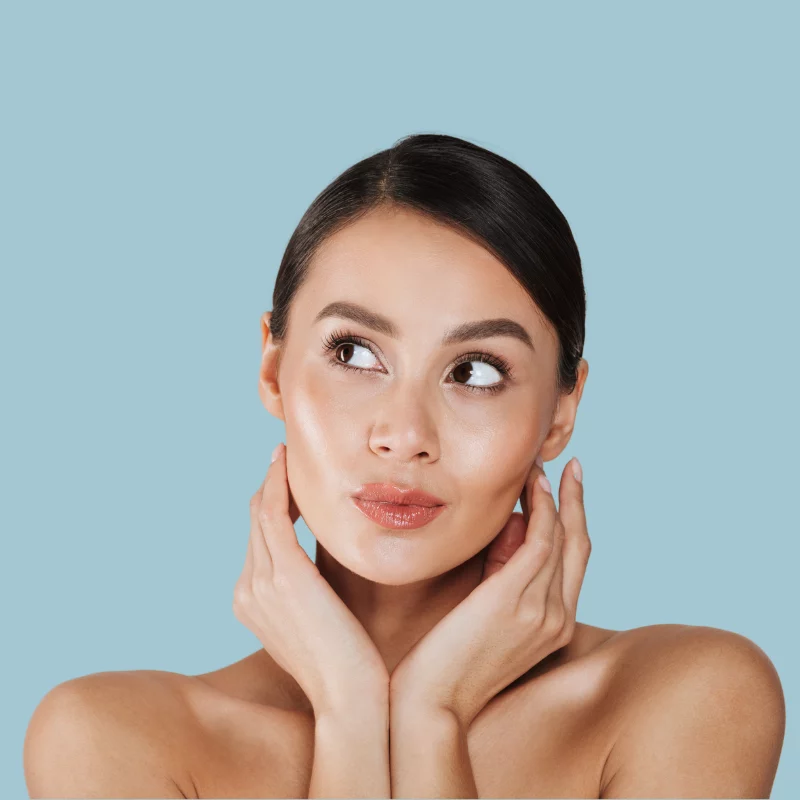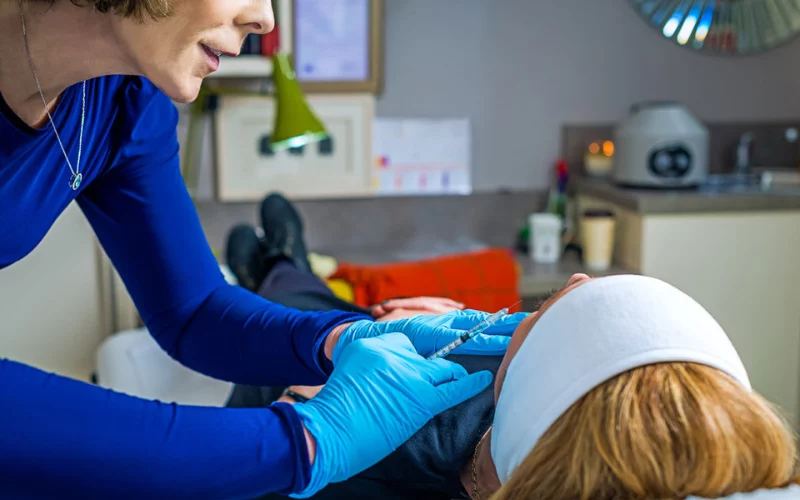
These are injections into the target muscle to temporarily block the nerve signal resulting in weakening of the muscle action which can result in an improvement in the appearance of lines of facial expression. These injections can only treat lines of expression (dynamic lines).
Lines that are present when the muscle is not contracted, and the face is relaxed (static lines) may soften once the injections have taken effect and with repeated treatment will continue to improve as the skin recovers and is no longer being creased by constant muscle action.
It blocks the transmission of the chemical signal from the nerve reaching the target muscle resulting in inability for the muscle to contract. The muscle remains in a resting relaxed state.
It is not always
desirable to stop all movement as a completely frozen look may not be aesthetically pleasing. It is therefore important to discuss your expectations with your practitioner.
I attentively listen to your needs, concerns, and the results you aspire to achieve. During our consultation, we collaborate to develop a customized treatment plan tailored specifically for you.
Your medical history is thoroughly reviewed to confirm your suitability for the chosen treatments, including assessments for allergies and any potential contraindications.
During your initial consultation, which I personally conduct, I will thoroughly assess your skin and facial muscles, as well as review any previous treatments you've had. This comprehensive facial assessment is crucial in developing a customized treatment plan that caters to your unique needs, whether it's for smoothing out wrinkles or tackling issues like excessive sweating.
Understanding that anti-wrinkle injections, while minimally invasive, can sometimes cause nervousness among clients, I always prioritize your comfort during the treatment. Typically, for anti-wrinkle injections, I use ice to enhance the comfort of your experience. This method is generally effective and well-tolerated. However, very rarely, if additional comfort is needed, I may apply a local anesthetic cream to the injection sites before proceeding with the treatment.
The procedure involves injecting a very fine needle with the correct dosage of the anti-wrinkle product into the target areas. The treatment is quick, usually lasting around 15-20 minutes, allowing you to resume your activities almost immediately.
Post-treatment, you may experience mild redness or swelling, which typically subsides within a few hours.


For Anti-Wrinkle Injections
Your Most Common Queries:
Here’s What I’m Often Asked About Anti-Wrinkle Injections
Treatment results are often more successful when the skin is in good condition, with good elasticity, where facial expressions are not excessive, and there are no or only minimal static lines in the area to be treated.
You may not be suitable for treatment if any of the following apply:
Millions of anti-wrinkle injection treatments have been performed worldwide and it has an excellent safety profile. However, as with any aesthetic procedure, there are certain risks and side effects which should be discussed with you during your initial consultation.
Over approximately 3-4 months, the nerve terminal recovers, and movement in the treated areas restarts. Treatment can be repeated at this time to maintain the desired results. It is not recommended to have treatments at intervals of less than 3 months. There are no known long-term side effects from having repeated treatments, although there may be some muscle wasting (atrophy) over time.
You will be asked to complete a medical questionnaire detailing your medical history, medications, and previous aesthetic treatments, etc. Before treatment, you will be given the opportunity to have any questions answered and to sign a consent form. The treatment area will be assessed, and the dosing and injection sites will be planned. Photographs will be taken at rest and while contracting the muscles (e.g., frowning, smiling, raising the brow).
Treatment usually takes 10-15 minutes. You will be lying on a treatment couch. The treatment area will be cleaned and disinfected. Ice is used to numb the area. You can expect 3-6 injections per treatment area. Very fine needles are used, and most people only experience minor discomfort. Very rarely, for people who cannot tolerate the procedure, an anaesthetic cream can be used to numb the area. Immediately after the treatment, you may have small, raised bumps on the skin where the injections have been placed. These should resolve within less than an hour.
You are advised not to engage in activities that increase blood flow to the injected areas for 48 hours. This includes avoiding vigorous exercise and limiting alcohol consumption (you may have a glass of wine or one beer). Headstands should also be avoided for 48 hours. You can resume your normal daily activities after treatment. Do not apply makeup for 12 hours following the treatment to minimize the risk of infection. Try to avoid touching or rubbing the treated area until the next day, as this may affect the results of the treatment.
The effects of the injections are not instant. Most people begin to notice the results approximately 4 days after treatment, with the full effect visible by day 14. You will be offered a follow-up appointment at the 2-week mark to determine if additional injections are necessary. It is advisable not to overdo the injections during the initial visit since more can be added at the 2-week follow-up, but an excess cannot be easily altered.
Yes, anti-wrinkle treatments can indeed be combined with other procedures. Think of them as the icing on a multi-layered cake of skincare treatments. Options like microneedling, quality skincare routines, PRP (Platelet-Rich Plasma), and Exosomes therapy are excellent for skin health and rejuvenation. Dermal fillers are particularly effective for replacing volume loss and repositioning tissues, such as in the case of jowls. While some of these treatments can be administered on the same day as anti-wrinkle injections, others may require a waiting period of about 2 weeks.
Before treatment, it’s important to avoid anti-inflammatory medications for 3 days, as they can increase your risk of bruising. Also, refrain from consuming alcohol, fish oils, Ginkgo Biloba, garlic, and vitamin E during this period to lessen the risk of bruising. If you are prone to bruising, consider taking arnica three days prior to your appointment, as it may help reduce this risk.
If you are unwell on the day of your scheduled treatment, it is advisable to reschedule.
Additionally, please inform the doctor of any changes to your medical history. To ensure you have adequate time for the treatment to take full effect and for any potential bruising to settle, avoid scheduling your treatment within two weeks of an important social event.
The chemical signal to the nerve that stimulates the muscle begins to resume normal activity approximately 8 weeks after receiving anti-wrinkle injections. By 12 weeks, the muscle typically regains its normal strength. The majority of people require retreatment roughly every 3-4 months.
However, this timeframe can vary depending on individual factors such as your body’s metabolism and lifestyle elements like exercise habits and smoking.
Yes, especially in the case of lines that appear only during facial expressions, known as active lines. Anti-wrinkle injections work by weakening the muscles and reducing their ability to contract, thereby preventing the formation of these lines. However, it’s important to note that excessive use of anti-wrinkle injections over a prolonged period can lead to muscle atrophy, which is the thinning of the muscle.
Anti-wrinkle injections can effectively treat various facial areas, including:
Additionally, these injections can also be used for:
After your treatment, you will be scheduled for a 2-week check-up appointment. During this visit, we will assess the muscle activity and repeat the photographs. Please note that any photographs taken are strictly part of your medical record and will not be used for any other purpose without your explicit consent. Additional anti-wrinkle injections may be necessary at this point.
If you are unable to attend your 2-week follow-up, we can reschedule your appointment, but it must be within 4 weeks of the initial treatment. This is because adjustments cannot be made after this timeframe.
Immediate side effects can include:
When selecting a practitioner for anti-wrinkle injections, consider the following steps:
Research Your Practitioner: In Ireland, it’s illegal for anyone other than a doctor or dentist to administer anti-wrinkle injections. Verify their credentials through their respective regulatory bodies, such as the Irish Medical Council for doctors. Inquire about their experience with anti-wrinkle injections, the specific training they’ve undergone, and the products they use.
Book a Preliminary Consultation: Schedule a consultation to discuss all your queries. This meeting is a crucial step in making an informed decision about proceeding with the treatment.
Inquire About Post-Treatment Support: Ask who will be your point of contact if something goes wrong or if you have any questions after the treatment. Is it a general hotline or direct contact with the doctor? For instance, in my practice, my clients have access to my personal number for any queries, and I personally oversee all aftercare.